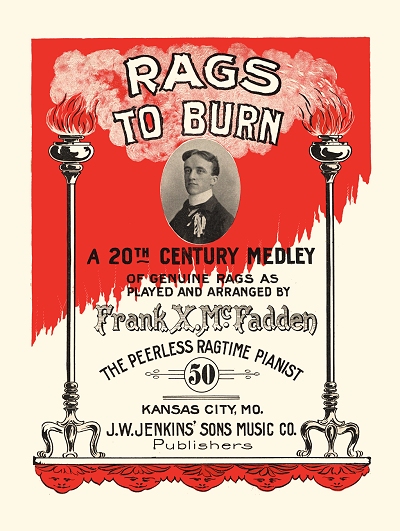|
Francis "Frank" Xavier McFadden (August 4, 1874 to September 21, 1912) |
 Compositions Compositions |
|
Rags to Burn (1899)
|
Kansas City was an important center of ragtime output, and even early jazz into the 1920s. Many succeeded there and went on to national fame. Some floundered but still had local success. Some just disappeared after achieving a short burst of notoriety. The latter is the tale of Francis Xavier McFadden, named after a saint, but probably not living like one. However, it is really a more tragic story of his mother and her unbearable losses throughout her life.
Francis was one of a set of twins born in Philadelphia, Pennsylvania, to William A. McFadden and his wife Katherine Ann Donnelly [possibly Catherine], the other being Joseph John. They were preceded by Charles A. (10/1872), and followed by Mary Rose (1/1876), Cornelius "Neil" (8/1879), and, after the couple relocated from Pennsylvania to Kansas City, Missouri, Katherine (4/1884). One - possibly two - other children died between the 1880 and 1900 censuses. It is unclear what kind of childhood Frank had within his large family, but he likely obtained any piano training while in Kansas City. By the mid-1890s he was working a clerk for an unknown firm.
It is unclear what kind of childhood Frank had within his large family, but he likely obtained any piano training while in Kansas City. By the mid-1890s he was working a clerk for an unknown firm.
 It is unclear what kind of childhood Frank had within his large family, but he likely obtained any piano training while in Kansas City. By the mid-1890s he was working a clerk for an unknown firm.
It is unclear what kind of childhood Frank had within his large family, but he likely obtained any piano training while in Kansas City. By the mid-1890s he was working a clerk for an unknown firm.The only real information on McFadden as a musician comes from the cover of his only known published work, the slightly over-long Rags to Burn, full influences from Missouri and Kansas folk strains, and issued in 1899 by the large Kansas City publishing firm of J.W. Jenkins Sons. On it, he is touted as "The Peerless Ragtime Pianist." The dearth of mentions of McFadden in Kansas City newspapers - any mention much less as a player - suggests a different story. Just the same, pianist Brunson Campbell wrote briefly about McFadden in an article that appeared in the 1940s, qualifying him simply as a fellow pianist. His own Chestnut Street in the 90s clearly shows a strong influence, and even direct quotes, derived from parts of Rags to Burn. As Campbell moved around quite a bit during that period, it is unlikely they had all that much of a friendship.
The 1900 census showed the McFadden family, or most of it, having briefly relocated to Arkansas in 1899, living in Kansas City, Missouri, with William managing a hotel. Frank, however, was found working as a clerk for an unknown firm in Chicago, Illinois, and boarding in a hotel. The 1900 Kansas City directory also indicated he had moved to Chicago. It is possible he went there to try and make more of a career as a pianist, but as with Kansas City, mentions of him in Chicago papers simply were not readily located. He pretty much dropped out of sight, certainly not intentionally, after Rags to Burn. As for Katherine, she had to endure the loss of her daughter Mary in 1902, then her namesake Katherine in 1903. Somewhere during the decade Charles also died, leaving only Neil and the twins by 1910. Neil would be gone before the year was out as well. William was working as a bookkeeper for the American Transfer Company [later P. Thomson], where he had been for several years.
Frank was not readily found in the 1910 census, but it is probable he had been back in Kansas City for some time, working as a pianist or at odd jobs. Directory listings for him around this time show no specific occupation. On September 21, 1912, Frank was found dead by the police with a fractured skull lying the street, evidently the victim of a mugging or bar fight. His occupation on the death certificate was listed as "musician/piano player," and his father William identified the body. Francis was buried at Mount Saint Mary's Cemetery in Kansas City, Missouri, where some of his siblings preceded him. Katherine's grief was not over. Frank's twin Joseph died on June 10, 1914, ironically or not of the same cause as Frank - a fractured skull. The coroner determined it to be a homicide. It may be possible they had the same enemies. This time it was his mother who identified the body. Katherine's husband William had died that same year in February. She survived more than another full decade, having lost all of her family in just over a dozen years, and is buried with them at Mount Saint Mary's.